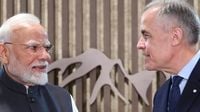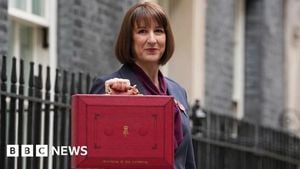After nearly two years of icy silence and diplomatic expulsions, India and Canada have taken a bold step toward reconciliation, rekindling hopes for a new era of partnership. On November 24, 2025, Indian Prime Minister Narendra Modi and Canadian Prime Minister Mark Carney met on the sidelines of the G20 summit in Johannesburg, South Africa, marking a significant thaw in relations that had been frozen since 2023. Their meeting was more than a polite handshake—it was the green light for a comprehensive reboot, as both leaders agreed to restart negotiations on a high-ambition Comprehensive Economic Partnership Agreement (CEPA), a move they hope will double bilateral trade to as much as $70 billion by 2030.
According to India’s Ministry of External Affairs, the two countries will soon embark on technical discussions, with Carney accepting Modi’s invitation to visit India early in 2026. Officials from both sides are expected to work feverishly ahead of that visit, laying the groundwork for what could become a transformative trade pact. It’s a remarkable turnaround considering that, just last year, trade between the two nations hovered at about C$31 billion (roughly US$22 billion), as reported by Canadian officials.
But how did relations deteriorate so badly in the first place? The answer lies in a series of escalating disputes, culminating in 2023 when Canada accused India of complicity in the killing of Sikh separatist leader Hardeep Singh Nijjar in Vancouver. Canadian authorities claimed to possess credible evidence linking Indian government agents to the murder, while India dismissed the allegations as "absurd" and baseless. The fallout was swift and severe: both countries expelled diplomats, suspended significant diplomatic, trade, and military ties, and called home their top envoys. Formal engagement ground to a halt, and the diplomatic chill lingered for nearly two years.
Despite this, economic ties proved surprisingly resilient. According to Reuters, bilateral trade crossed $30 billion in 2024, with India emerging as Canada’s seventh-largest trading partner in goods and services. Yet, the broader relationship remained stuck in neutral. Behind closed doors, however, a quiet shift began to take shape in early 2025. Mark Carney, newly installed as Canada’s Prime Minister, made repairing relations with India a top priority. He pledged to rebuild trust and restore communication, a commitment that set the stage for a gradual thaw.
Diplomatic channels slowly reopened. Senior officials resumed contact, holding discreet meetings on national security and intelligence. Both governments named new ambassadors in the summer of 2025, signaling a fresh willingness to engage. Carney, speaking to reporters just before his meeting with Modi, underscored the urgency: “It’s important to get better trade access to one of the world’s largest and fastest-growing economies.” According to the Indian Prime Minister’s Office, the leaders agreed to pursue a “high-ambition” CEPA, with the aim of more than doubling trade by the end of the decade.
The focus of these renewed talks is broad and ambitious. Education stands out as a pillar of cooperation, with Canada hosting one of the world’s largest populations of Indian international students. Both sides anticipate less friction in visa processing, expanded research collaborations, and new institutional exchanges. As officials from both countries put it, these efforts will support further student mobility and academic partnerships, building bridges that had been battered by recent tensions.
Agriculture is another area ripe for collaboration. Canada, a major producer of pulses, grains, and fertilizers, sees India as a vast and growing market. As the two nations return to the negotiating table, they are expected to hammer out reduced tariffs and clearer import rules, while also exploring new ways to cooperate on food security. This could mean more Canadian lentils on Indian plates and more predictable trade for Canadian farmers.
Clean energy and climate technology are also high on the agenda. Canada is keen to export its expertise in hydrogen, carbon capture, and renewable energy, while India is searching for partners to help it pivot away from fossil fuels. The hope is that this renewed dialogue will pave the way for joint investments in green infrastructure, aligning the two countries’ interests in sustainable development.
Civil nuclear technology, a sensitive topic in years past, is poised for a comeback. Canada has long supplied India with nuclear fuel and technology, and with India ramping up its civilian nuclear program to meet surging electricity demands, both sides appear ready to expand cooperation. Reuters highlighted plans for long-term uranium supply arrangements, a sign that even the most delicate areas of partnership are back on the table.
Perhaps most crucially, the mobility of skilled workers is getting a fresh look. Canada faces persistent labor shortages in sectors like healthcare, transportation, and construction. India, meanwhile, boasts a deep pool of skilled labor. Both governments are exploring easier pathways for temporary and long-term work arrangements, betting that such mobility will benefit their economies and societies alike.
It’s not all smooth sailing, of course. As Carney himself admitted, “sources of friction” remain. Indian officials have long criticized what they see as Canadian leniency toward Sikh separatist groups, while Canadian authorities continue to press for accountability in the Nijjar case, with criminal charges laid and a trial pending. Past incidents—like the 2018 controversy over a former Sikh separatist’s invitation to an official event during Justin Trudeau’s India visit, or the 2020 spat over the Indian farmers’ protests—have left scars that won’t heal overnight.
Still, the momentum is unmistakable. Canada, which sells the vast majority of its exports to the United States, is eager to diversify. Protectionist winds from Washington have prompted Ottawa to set an ambitious goal: double non-US exports by 2035. India, for its part, is keen to deepen ties with a G7 partner and open its markets to new opportunities. As both countries look to the future, the hope is that a “high-ambition” CEPA will not only boost trade but also restore the trust and goodwill that were so badly damaged.
As technical teams get to work and the world watches, the India-Canada story is shifting from one of suspicion and estrangement to one of cautious optimism and renewed engagement. The coming months will reveal whether this diplomatic detente can withstand the pressures of old grievances and new ambitions—but for now, both sides seem ready to turn the page.




